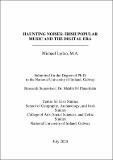| dc.contributor.advisor | Ní Fhuartháin, Méabh | |
| dc.contributor.author | Lydon, Michael | |
| dc.date.accessioned | 2020-11-17T09:58:24Z | |
| dc.date.available | 2020-11-17T09:58:24Z | |
| dc.date.issued | 2020-11-16 | |
| dc.identifier.uri | http://hdl.handle.net/10379/16283 | |
| dc.description.abstract | This research examines the response of Irish popular musicians to the changing modes of reception and production in the digital era. In this examination, the use of both media and environmental noise in the recording process is revealed to be crucial in facilitating attentive listening. To undertake this assessment, the temporal framework of Irish popular music’s digital era is shown to correspond with its revolutionary period between the early 1990s and mid-2010s. In addition, central to assessing the challenges facing Irish popular musicians is a contextualisation of the impact of dominant modes of reception in the digital era. To define a response to the creative impact of these dominant modes of reception, this study focuses on the production of an album and the inventive use of music, silence, and importantly noise to construct what the research outlines as a temporospatial expanses of sonic fiction. The musicians whose response is examined in this thesis include Damien Dempsey, Sinéad O’Connor, and Mic Christopher.
To undertake this examination of Irish popular musicians’ response to the digital era, the thesis utilises the multi interpretive modes of enquiries afforded in Irish Studies to broaden an understanding of the response. In adopting an Irish Studies approach to cultural analysis, this research incorporates critical theories from Popular Music Studies; Sound Studies; Literature; Poststructuralist theories relating to hauntology and the omnipresence of the photographic image; and phonomusicology to arrive at a new critical approach to examine popular music’s creative response to the digital era. Ultimately, the thesis uncovers that Irish popular musicians in their response to the digital era utilise noise as part of a hauntological metalanguage of remembered punctums to construct temporospatial expanses of sonic fiction that propel the industry into a newly formed future; thus, revealing the haunting noises of Irish popular music in the digital era. | en_IE |
| dc.publisher | NUI Galway | |
| dc.rights | Attribution-NonCommercial-NoDerivs 3.0 Ireland | |
| dc.rights.uri | https://creativecommons.org/licenses/by-nc-nd/3.0/ie/ | |
| dc.subject | Irish Popular Music | en_IE |
| dc.subject | Digital Era | en_IE |
| dc.subject | Noise | en_IE |
| dc.subject | Hauntology | en_IE |
| dc.subject | Irish Studies | en_IE |
| dc.subject | Geography, Archaeology and Irish Studies | en_IE |
| dc.subject | Arts, Social Sciences and Celtic Studies | en_IE |
| dc.title | Haunting noises: Irish popular music and the digital era | en_IE |
| dc.type | Thesis | en |
| dc.contributor.funder | Doctoral Fellowship in Irish Music Studies | en_IE |
| dc.local.note | The thesis examines Irish popular music's response to changing modes of reception and production in the digital era. It reveals the response to be in part the use of noise as a sonic component in a hauntological metalanguage of remembered of punctums in creating temporospatial expanses of sonic fiction. | en_IE |
| dc.local.final | Yes | en_IE |
| nui.item.downloads | 841 | |


